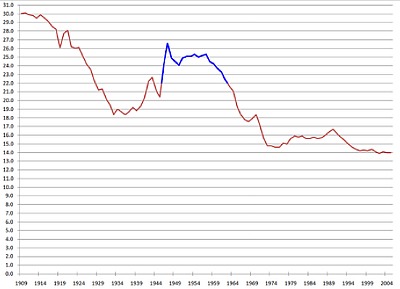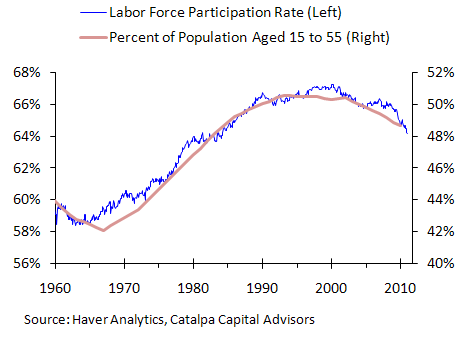James Pethokoukis of Reuters looks at the job numbers out this morning, which showed headline unemployment dropping to 8.9 percent, and says by his calculation the number would be a third higher if so many people hadn’t given up looking for work:
If the labor force was currently at 2007 levels, the unemployment rate would be a whopping 12.1 percent – the worst since the Great Depression.
Your first question when reading something like that should be: Why isn’t the labor force currently at 2007 levels? What larger forces are causing people to quit looking for work? One of the biggies, obviously, is that there’s not just enough demand for labor. Pethokoukis, with his headline “The new underclass and Barack Obama,” would have you believe that’s the entire problem and it’s you-know-who’s fault.
But the elephant in the room here is the Baby Boomers, who have been hitting retirement age in the last several years. The first Boomers were born in 1946, and turn 65 this year—the classic retirement age. But Boomers unlike us Gen Xers (UPDATE: James points out in comments that I was wrong here. Everyone can take early Social Security at 62) can retire at 62 and take Social Security. Lots of them have old-fashioned things called “pensions” that allow them to retire at 55 or 60. Others have enough in their 401ks or IRAs to quit working for the man, as they once might have put it.
The Boomers, statistically, look like the pig in the python:
So doesn’t it make sense that that bulge is working its way through the system?
Indeed, the labor participation rate didn’t just start falling in 2007, when the recession began. It peaked at 67.3 percent in 2000, dropped to 66 percent by 2007 and now sits at 64.2 percent. Coincidentally, Boomers started turning 55—the classic early-retirement age—in 2001. This chart from Catalpa Capital shows the correlation nicely:
But wait a second: The BLS says participation rates for the over-55 cohort has actually increased, not decreased, during the recession. How does that jibe with Boomers being the cause of much of the labor participation rate decline?
Because even though a higher percentage of Boomers work than do in the generation that precedes them, they’re far less likely to work than the 25 to 54 year olds who are in their prime working years and make up the bulk of the labor force. The BLS explained that a few years ago:
In 1990 and 2000, the entirety of the baby-boom generation was in the prime age group—the group with the highest attachment to the labor market and with the highest labor force participation rate. Every year after 2000, some of the baby boomers exited the group with the highest attachment to the labor market—the prime age group—and entered the 55-years-and-older age group—the group with participation rates approximately half those of the prime age group. This transformation was one of the causes of the drop in the overall labor force participation rate, a de- cline that reversed the trend of previous decades wherein the baby-boom generation moved from ages with lower labor force participation rates to ages with higher rates, increasing the rate of growth of the labor force.
The oldest of the boomers celebrated their sixtieth birthdays in 2006 and will turn 62 in 2008, when they will become eligible for early retirement benefits. In 2011, the midpoint of the BLS 2006-16 projection timeframe, they will turn 65. Other things remaining equal, as the baby-boom generation retires or moves to age groups with lower participation, the rate of growth of the labor force will slow down significantly, implying a slower growth of GDP.
That certainly doesn’t mean the aging of the workforce is reponsible for all of the labor-force participation decline. Indeed, some of those Boomers retiring may have worked longer if the job market were better. I don’t want to minimize how dismal the economy has been and still is and how hard it is to find work.
But Bloomberg reported last month that a UBS economist estimates that half of the labor-force participation rate decline is due to the aging of the workforce. How much of the other half is due to the policies of Barack Obama, as Pethokoukis would have it, or George W. Bush, under whom the recession and financial crash started, is a debate for another day.
This points to a larger blind spot in the press: That much of the economy is dictated by demographics. And it’s not just the press. Here’s the UBS economist Bloomberg quoted:
“There’s a cyclical downturn in the labor force participation rate, but there’s also a structural one related to the baby boomers that a lot of Wall Street economists are missing,” Matus said. “When you add the two up, you’re seeing this very dramatic drop in the participation rate. It might not bounce this time around.”
We like to think that stuff happens because we implemented policies that worked or backfired: X policy is the reason we have Y consequence. I guess it makes us feel good to think that what we’re doing matters more than it really does.
Sometimes there are forces out there larger than tax cuts or stimulus bills.
Ryan Chittum is a former Wall Street Journal reporter, and deputy editor of The Audit, CJR’s business section. If you see notable business journalism, give him a heads-up at rc2538@columbia.edu. Follow him on Twitter at @ryanchittum.


